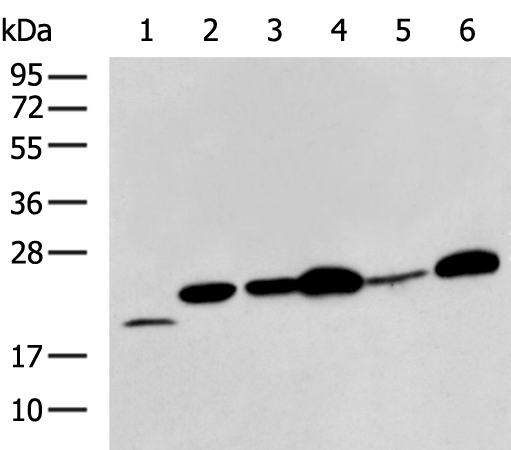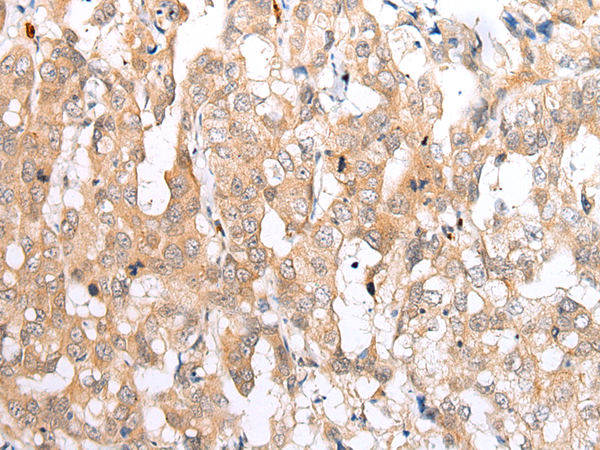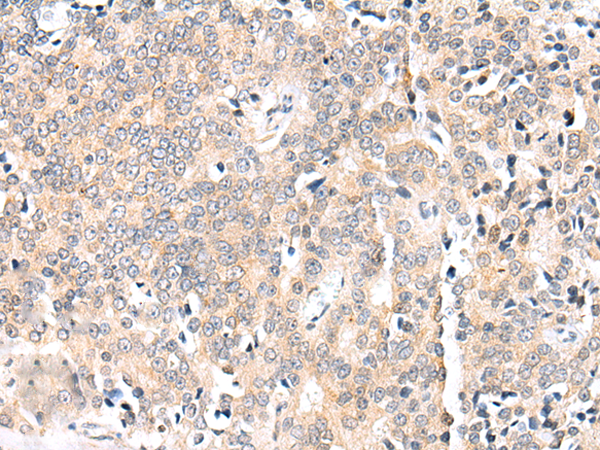


| WB | 咨询技术 | Human,Mouse,Rat |
| IF | 咨询技术 | Human,Mouse,Rat |
| IHC | 1/20-1/100 | Human,Mouse,Rat |
| ICC | 技术咨询 | Human,Mouse,Rat |
| FCM | 咨询技术 | Human,Mouse,Rat |
| Elisa | 1/5000-1/10000 | Human,Mouse,Rat |
| Aliases | BAM; BIM; BOD |
| WB Predicted band size | 22 kDa |
| Host/Isotype | Rabbit IgG |
| Antibody Type | Primary antibody |
| Storage | Store at 4°C short term. Aliquot and store at -20°C long term. Avoid freeze/thaw cycles. |
| Species Reactivity | Human, Mouse, Rat |
| Immunogen | Synthetic peptide of human BCL2L11 |
| Formulation | Purified antibody in PBS with 0.05% sodium azide and 50% glycerol. |
+ +
以下是关于BCL2L11抗体的参考文献及其摘要概括:
1. **"BCL2L11/BIM as a dual agent of apoptosis and autophagy in cancer"**
*作者:Akiyama et al.*
摘要:研究揭示了BCL2L11(BIM)通过调控凋亡和自噬在癌症中的作用,利用特异性抗体证实其在肿瘤细胞中的表达水平与化疗敏感性相关,低表达可能导致耐药性。
2. **"Antibody-based detection of BCL2L11 isoforms in apoptotic signaling"**
*作者:Chen et al.*
摘要:开发了一种高特异性BCL2L11抗体,用于区分不同异构体,发现特定异构体在TNF-α诱导的凋亡中起关键作用,Western blot和免疫荧光验证其亚细胞定位。
3. **"BCL2L11 suppression in melanoma confers resistance to BRAF inhibitors"**
*作者:Villanueva et al.*
摘要:通过免疫组化分析黑色素瘤样本,发现BCL2L11低表达与BRAF抑制剂耐药性相关,抗体检测显示其表达受MAPK通路调控,上调可恢复药物敏感性。
4. **"BCL2L11/BIM regulates T cell homeostasis and autoimmunity"**
*作者:Hildeman et al.*
摘要:利用BCL2L11抗体研究T细胞凋亡,发现BIM缺陷导致自身免疫疾病模型中的T细胞异常累积,强调其在维持免疫稳态中的关键作用。
以上研究均通过BCL2L11抗体探讨了其在不同疾病模型中的表达、功能及治疗意义。
The BCL2L11 gene encodes Bim (BCL-2 interacting mediator of cell death), a pro-apoptotic member of the BCL-2 protein family. Bim contains a BH3 domain critical for its function in promoting apoptosis by binding and neutralizing anti-apoptotic proteins like BCL-2 and BCL-xL. It is regulated transcriptionally and post-translationally, with activity influenced by growth factor signaling, stress stimuli, and phosphorylation. Bim exists as multiple isoforms (BimEL, BimL, BimS) generated by alternative splicing, each differing in apoptotic potency.
Antibodies targeting Bim are essential tools for studying its expression, localization, and interactions in apoptosis regulation. They are widely used in techniques such as Western blotting, immunohistochemistry (IHC), and flow cytometry to assess Bim levels in diseases like cancer, where its downregulation is linked to therapy resistance. Specificity varies among antibodies; some detect all isoforms, while others target unique regions. Researchers also employ Bim antibodies to investigate its role in autoimmune disorders, neurodegenerative conditions, and hematopoietic cell homeostasis.
Therapeutic interest in Bim stems from its potential as a biomarker for treatment response and its involvement in mechanisms of BH3 mimetic drugs. Dysregulation of Bim contributes to pathological cell survival, making it a focus for developing strategies to restore apoptosis in resistant cancers.
×